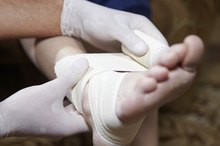Rehab Exercises for Stress Fractures From Running
Running causes repeated stress to be placed on the bones and tissues in your feet and legs. Over time, injuries such as stress fractures can result. As a tiny break in a bone, stress fractures are painful but do not always cause disability or immobility.
Stress fractures from running often occur in the shinbone or feet. Rest, ice and other methods to relieve pain are often recommended as treatment options. Your doctor also may recommend exercises and stretches to strengthen the areas around the fracture.
Stress Fractures
Runners experience stress fractures as a result of overtraining, improper footwear and running on hard or irregular surfaces. During overtraining, muscles become fatigued and are no longer able to absorb the shock from repeated impacts.
Thus, muscles transfer stress to the bones in your feet and legs, resulting in small cracks or fractures. The most common areas for stress fractures, according to the American Academy of Orthopaedic Surgeons, are the second and third metatarsals -- or the long bones -- of the feet. Stress fractures also affect the heel, the navicular bone that sits below the ankle and the bones in the shin.
- Runners experience stress fractures as a result of overtraining, improper footwear and running on hard or irregular surfaces.
- Thus, muscles transfer stress to the bones in your feet and legs, resulting in small cracks or fractures.
Healing Time
Rehab Exercises After MCL Injury
Learn More
Before beginning any rehabilitation exercises, the stress fracture needs time to heal. It typically takes six to eight weeks for a stress fracture to heal, depending on its severity. Your doctor may recommend avoiding aggravating activities such as running. During your recovery, swimming and cycling are acceptable forms of cardiovascular activity that can help you maintain your fitness level.
After your prescribed amount of rest, your doctor will develop a rehabilitation program. He might recommend alternating days of activity and rest at the beginning of the program, slowly increasing the frequency, duration and intensity.
- Before beginning any rehabilitation exercises, the stress fracture needs time to heal.
Stretching Exercises
Stress fractures of the foot can benefit from flexibility exercises that stretch the bottoms of the feet. Gentle stretching can be performed as soon as swelling or acute pain decreases. The plantar fascia, the fibrous tendon of the foot, connects your heel and ball of your foot, forming your arch. It absorbs much of the impact of bipedal motion. Stretching it can increase its flexibility, and prevent injury. Sit on the floor and bend one knee toward you. Grasp your toes and gently pull them toward your shin. Hold the stretch for up to 30 seconds. Stretching your calves also can help maintain strength and flexibility in your lower legs, as well as stretch your sole. Lean forward with your hands on a wall, placing one foot in front of the other. Straighten the back leg and lean forward until you feel a stretch in your calf.
- Stress fractures of the foot can benefit from flexibility exercises that stretch the bottoms of the feet.
- Stretching your calves also can help maintain strength and flexibility in your lower legs, as well as stretch your sole.
Strengthening Exercises
Recovery Time for a Torn Plantar Fascia
Learn More
You can usually begin strengthening exercises with doctor approval after your stress fracture has healed.
Building strength in your foot and lower leg can help prevent future stress fractures from occurring. Muscle strength keeps the stress of running from affecting your bones.
Pointing and flexing your foot strengthens the soft tissues in your feet. As you get stronger, add resistance with a towel or exercise band. You also can grasp a towel with your toes, eventually holding the contraction for up to 30 seconds. Calf raises, where you rise up onto your toes, can help strengthen your feet as well as the muscles in your lower leg.
- You can usually begin strengthening exercises with doctor approval after your stress fracture has healed.
- Calf raises, where you rise up onto your toes, can help strengthen your feet as well as the muscles in your lower leg.
Related Articles
References
- Running Times; Stress Fractures; S. Karas; September 2005
- American Academy of Orthopaedic Surgeons: Stress Fractures of the Foot and Leg
- American Academy of Orthopaedic Surgeons: Plantar Fasciitis and Bone Spurs
- Kiel J, Kaiser K. Stress reaction and fractures. Treasure Island, FL: StatPearls Publishing. Updated June 4, 2019.
- Chen YT, Tenforde AS, Fredericson M. Update on stress fractures in female athletes: epidemiology, treatment, and prevention. Curr Rev Musculoskelet Med. 2013;6(2):173-81. doi:10.1007/s12178-013-9167-x
- American Academy of Orthopaedic Surgeons. Stress fractures of the foot and ankle.
- Cleveland Clinic. Stress fractures: Prevention. Updated June 17, 2015.
- Deepak S. Patel, et. al. "Stress Fractures: Diagnosis, Treatment, and Prevention," Am Fam Physician. 2011 Jan 1;83(1):39-46.
- Stress Fracture - Patient Information. American Academy of Orthopaedic Surgeons.
- Raija Korpelainen, MSc, et al. Risk Factors for Recurrent Stress Fractures in Athletes. The American Journal of Sports Medicine. May 2001 29:304-310.
Writer Bio
Christy Callahan has been researching and writing in the integrative health care field for over five years, focusing on neuro-endocrinology. She has a Bachelor of Science degree in biology, earned credits toward a licensure in traditional Chinese medicine and is a certified Pilates and sport yoga instructor.









